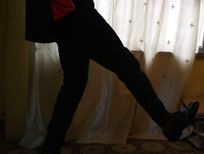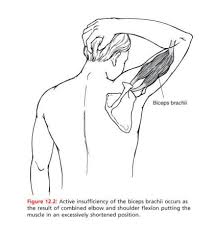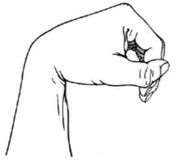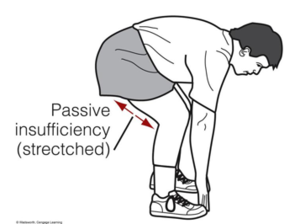Active and Passive Insufficiency: Difference between revisions
mNo edit summary |
mNo edit summary |
||
| Line 5: | Line 5: | ||
</div> | </div> | ||
== Introduction == | == Introduction == | ||
The amount of force or tension generated by a multi-joint muscle (muscle that crosses two or more joints) diminishes as the muscle moves the joints simultaneously. | The amount of force or tension generated by a multi-joint muscle (muscle that crosses two or more joints) diminishes as the muscle moves the joints simultaneously. This is referred to as muscle insufficiency. It can either be passive or active. | ||
== Active Insufficiency == | == Active Insufficiency == | ||
When a prime mover (agonist) becomes shortened to the point that it cannot generate or maintain active tension, active insufficiency is reached | The active insufficiency of a muscle that crosses two or more joints occurs when the muscle produces simultaneous movement at all the joints it crosses and reaches such a shortened position that it no longer has the ability to develop effective tension<ref>Clarkson HM. Musculoskeletal assessment: joint range of motion and manual muscle strength. Lippincott Williams & Wilkins; 2000.</ref>. When a prime mover (agonist) becomes shortened to the point that it cannot generate or maintain active tension, active insufficiency is reached. | ||
* The hip cannot be fully flexed, and the knee fully extended simultaneously, because of the shortening of the rectus femoris. | * The hip cannot be fully flexed, and the knee fully extended simultaneously, because of the shortening of the rectus femoris. | ||
[[File:Hip flexion 1.jpg|thumb|alt=Hip flexion|237x237px|Hip flexion without knee extension|center]] | [[File:Hip flexion 1.jpg|thumb|alt=Hip flexion|237x237px|Hip flexion without knee extension|center]] | ||
| Line 15: | Line 15: | ||
* Maximal shoulder flexion cannot be achieved simultaneously with maximal elbow flexion due to the shortening of the [[Biceps brachii]]. | * Maximal shoulder flexion cannot be achieved simultaneously with maximal elbow flexion due to the shortening of the [[Biceps brachii]]. | ||
*[[File:Active insufficiency of biceps brachii.jpg|center|thumb]]{{#ev:youtube|FT7OABz8I5k}} | *[[File:Active insufficiency of biceps brachii.jpg|center|thumb]]{{#ev:youtube|FT7OABz8I5k}} | ||
== Passive Insufficiency == | == Passive Insufficiency == | ||
When the opposing muscle (antagonist) is stretched to a point where it can no longer lengthen and allow further movement, passive insufficiency is reached. Passive insufficiency occurs when a multi-joint muscle is lengthened to its fullest extent at both joints, but also preventing the full range of motion of each joint it crosses.<ref name=":0" /> | When the opposing muscle (antagonist) is stretched to a point where it can no longer lengthen and allow further movement, passive insufficiency is reached. Passive insufficiency occurs when a multi-joint muscle is lengthened to its fullest extent at both joints, but also preventing the full range of motion of each joint it crosses.<ref name=":0">1. Rogers M, Rogers M. Understanding Active and Passive Insufficiency [Internet]. National Federation of Professional Trainers. 2020 [cited 17 September 2020]. Available from: https://www.nfpt.com/blog/understanding-active-and-passive-insufficiency</ref> | ||
* Full finger flexion cannot be achieved if wrist flexion occurs simultaneously.[[File:Passive insufficiency.jpg|thumb|182x182px|center]] | * Full finger flexion cannot be achieved if wrist flexion occurs simultaneously.[[File:Passive insufficiency.jpg|thumb|182x182px|center]] | ||
*Maximal hip flexion and maximal knee extension are limited by the lengthening of the [[Hamstrings]].[[File:Passive insufficiency of the hamstrings.png|center|thumb]] | *Maximal hip flexion and maximal knee extension are limited by the lengthening of the [[Hamstrings]].[[File:Passive insufficiency of the hamstrings.png|center|thumb]] | ||
{{#ev:youtube|vCEYDZvox2s}} | {{#ev:youtube|vCEYDZvox2s}} | ||
== '''Clinical Relevance''' == | |||
During rehabilitation, each joint should be moved individually through its available range of motion in order to maintain or improve the amount of range of motion at that joint. | |||
== References == | == References == | ||
Revision as of 15:54, 21 September 2020
Original Editor -Innocent Abugu
Top Contributors - Innocent Abugu, Lucinda hampton, Alicia Fernandes and Kim Jackson
Introduction[edit | edit source]
The amount of force or tension generated by a multi-joint muscle (muscle that crosses two or more joints) diminishes as the muscle moves the joints simultaneously. This is referred to as muscle insufficiency. It can either be passive or active.
Active Insufficiency[edit | edit source]
The active insufficiency of a muscle that crosses two or more joints occurs when the muscle produces simultaneous movement at all the joints it crosses and reaches such a shortened position that it no longer has the ability to develop effective tension[1]. When a prime mover (agonist) becomes shortened to the point that it cannot generate or maintain active tension, active insufficiency is reached.
- The hip cannot be fully flexed, and the knee fully extended simultaneously, because of the shortening of the rectus femoris.
- Maximal shoulder flexion cannot be achieved simultaneously with maximal elbow flexion due to the shortening of the Biceps brachii.
Passive Insufficiency[edit | edit source]
When the opposing muscle (antagonist) is stretched to a point where it can no longer lengthen and allow further movement, passive insufficiency is reached. Passive insufficiency occurs when a multi-joint muscle is lengthened to its fullest extent at both joints, but also preventing the full range of motion of each joint it crosses.[2]
- Full finger flexion cannot be achieved if wrist flexion occurs simultaneously.
- Maximal hip flexion and maximal knee extension are limited by the lengthening of the Hamstrings.
Clinical Relevance[edit | edit source]
During rehabilitation, each joint should be moved individually through its available range of motion in order to maintain or improve the amount of range of motion at that joint.
References[edit | edit source]
- ↑ Clarkson HM. Musculoskeletal assessment: joint range of motion and manual muscle strength. Lippincott Williams & Wilkins; 2000.
- ↑ 1. Rogers M, Rogers M. Understanding Active and Passive Insufficiency [Internet]. National Federation of Professional Trainers. 2020 [cited 17 September 2020]. Available from: https://www.nfpt.com/blog/understanding-active-and-passive-insufficiency











